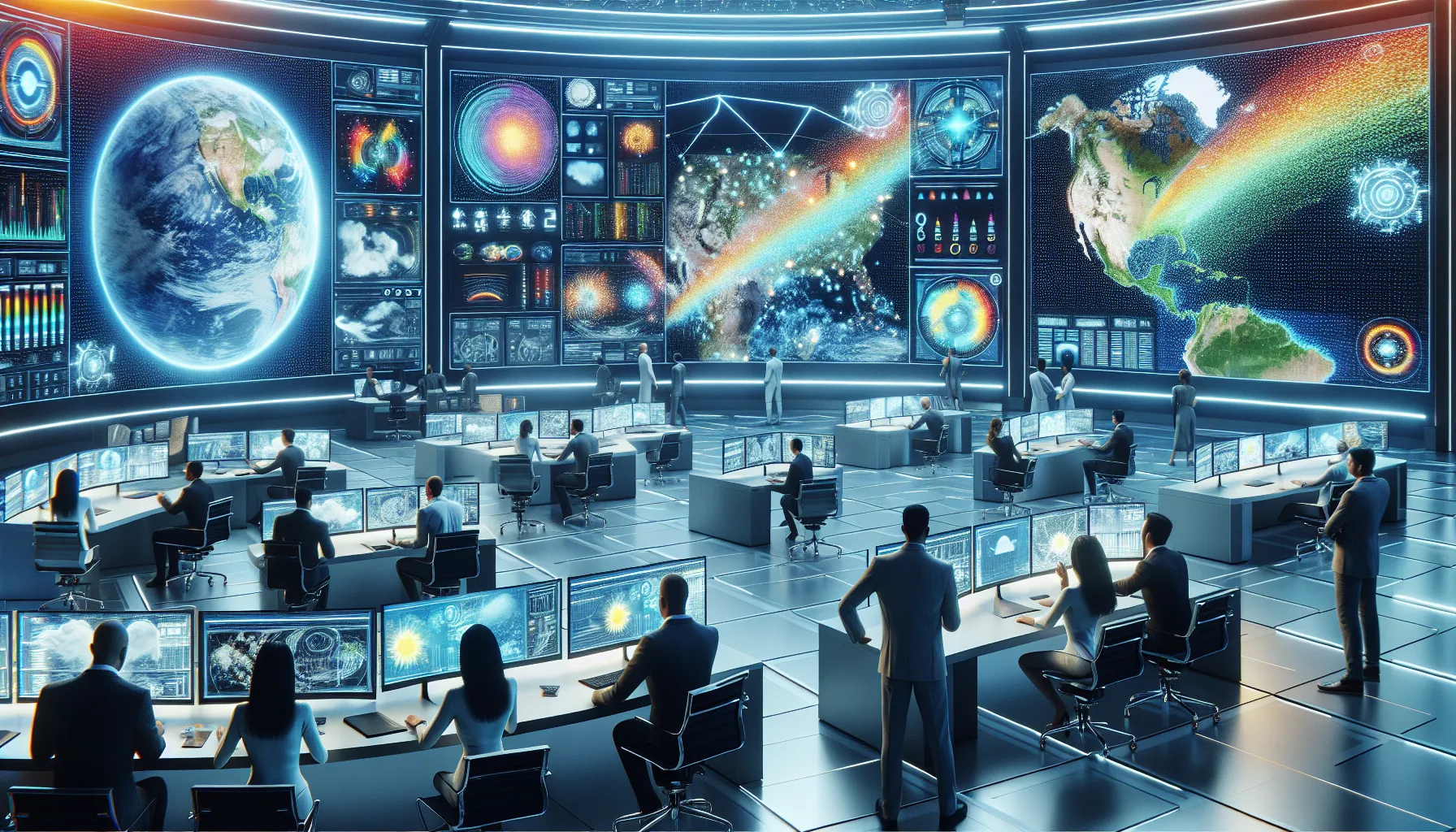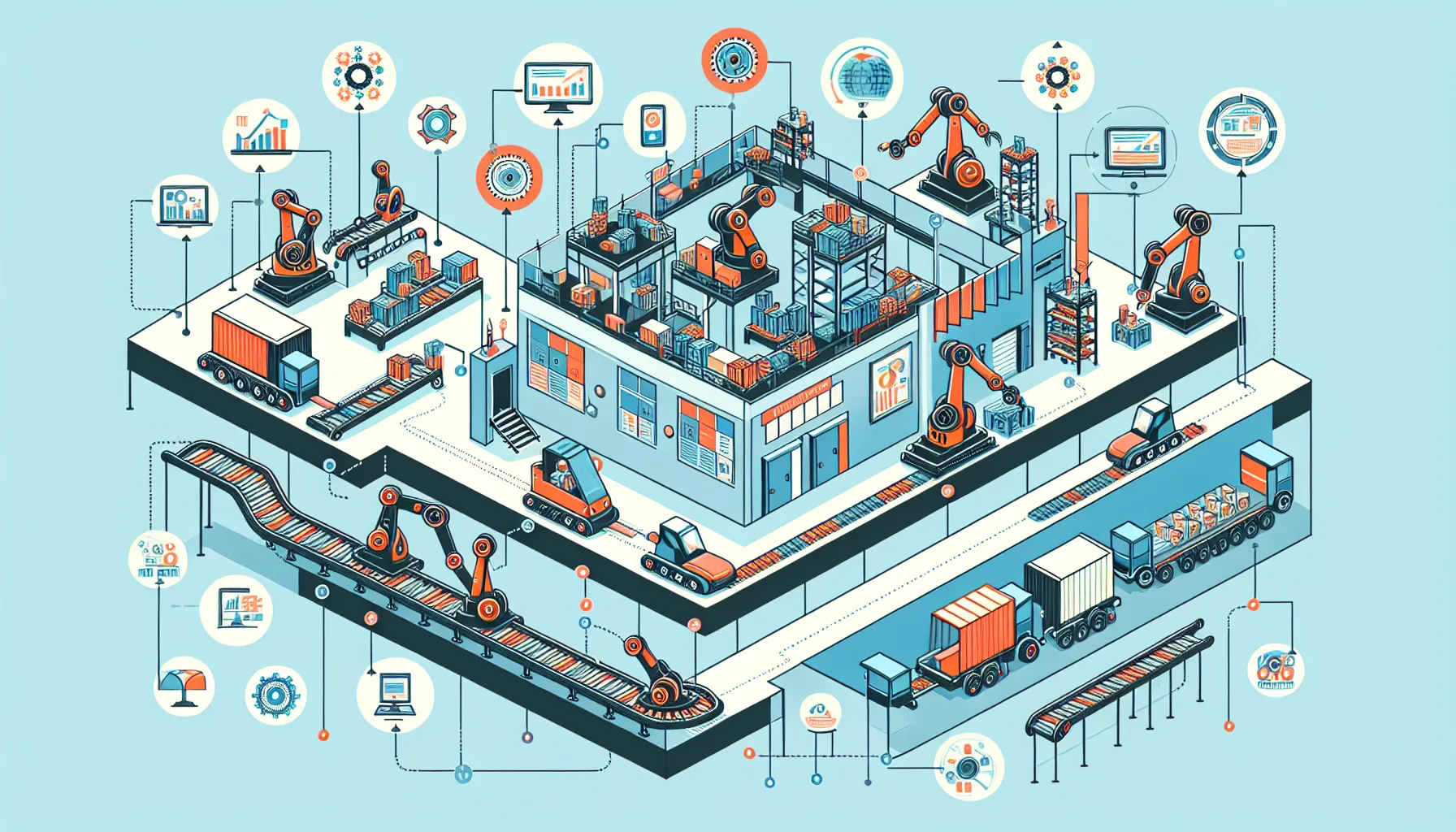Welcome to our IELTS Reading practice test focused on the fascinating topic of “AI in Weather Forecasting.” This test will help you prepare for the IELTS Reading section while exploring how artificial intelligence is revolutionizing meteorology. Let’s dive into the passages and questions to enhance your reading skills and knowledge about this cutting-edge technology.
Table Of Contents
- Passage 1 – Easy Text
- The Rise of AI in Weather Forecasting
- Questions 1-5
- Questions 6-10
- Passage 2 – Medium Text
- AI Technologies Revolutionizing Weather Prediction
- Questions 11-15
- Questions 16-20
- Passage 3 – Hard Text
- The Ethical Implications and Future Prospects of AI in Meteorology
- Questions 21-26
- Questions 27-30
- Answer Key
- Passage 1 – Easy Text
- Passage 2 – Medium Text
- Passage 3 – Hard Text
 AI in weather forecasting
AI in weather forecasting
Passage 1 – Easy Text
The Rise of AI in Weather Forecasting
Artificial Intelligence (AI) is transforming numerous industries, and meteorology is no exception. In recent years, the integration of AI into weather forecasting has led to significant improvements in accuracy and efficiency. Traditional forecasting methods rely heavily on complex mathematical models and human interpretation of data. However, AI-powered systems can process vast amounts of information much faster and identify patterns that might be imperceptible to human forecasters.
One of the key advantages of AI in weather forecasting is its ability to analyze historical weather data alongside real-time information. This combination allows for more nuanced predictions, especially in areas with volatile weather patterns. Machine learning algorithms can quickly adapt to new data, continuously improving their forecasting capabilities.
Moreover, AI systems can incorporate data from a wide range of sources, including satellites, weather stations, and even social media reports. This comprehensive approach provides a more holistic view of weather conditions, leading to more accurate forecasts. The integration of AI has also enabled meteorologists to extend the range of reliable forecasts from a few days to up to two weeks in advance.
While AI has undoubtedly enhanced weather forecasting, it’s important to note that human expertise remains crucial. Meteorologists play a vital role in interpreting AI-generated forecasts, understanding local weather phenomena, and communicating predictions to the public. The synergy between human knowledge and AI capabilities is what truly drives the advancement of modern weather forecasting.
Questions 1-5
Do the following statements agree with the information given in the passage?
Write
TRUE if the statement agrees with the information
FALSE if the statement contradicts the information
NOT GIVEN if there is no information on this
- AI can process weather data faster than traditional forecasting methods.
- Machine learning algorithms in weather forecasting cannot adapt to new data.
- AI-powered systems can analyze both historical and real-time weather data.
- The use of AI in weather forecasting has made human meteorologists obsolete.
- AI has enabled reliable weather forecasts to be extended up to two weeks in advance.
Questions 6-10
Complete the sentences below.
Choose NO MORE THAN TWO WORDS from the passage for each answer.
- Traditional forecasting methods depend on complex mathematical models and ____ ____ of data.
- AI systems can identify weather patterns that might be ____ to human forecasters.
- Machine learning algorithms can adapt quickly to new data, which leads to ____ ____ capabilities.
- AI-powered weather forecasting systems can incorporate data from various sources, including ____ reports.
- The combination of human expertise and AI capabilities is driving the ____ of modern weather forecasting.
Passage 2 – Medium Text
AI Technologies Revolutionizing Weather Prediction
The field of meteorology has witnessed a paradigm shift with the advent of AI technologies. These innovative tools are not only enhancing the accuracy of weather forecasts but also revolutionizing the way we understand and predict atmospheric phenomena. Let’s explore some of the key AI technologies that are making a significant impact in this domain.
One of the most promising applications of AI in weather forecasting is the use of deep learning neural networks. These sophisticated algorithms can analyze complex weather patterns and identify subtle correlations that might escape traditional forecasting methods. For instance, researchers at Google have developed a deep learning model that can predict precipitation with remarkable accuracy up to six hours in advance. This technology, known as “nowcasting,” has the potential to provide crucial short-term weather information for various sectors, including aviation and emergency services.
Another groundbreaking AI application is the use of computer vision techniques to analyze satellite imagery. AI algorithms can now automatically detect and track weather systems, such as hurricanes and severe storms, with unprecedented precision. This capability allows meteorologists to monitor the development and movement of weather phenomena in real-time, leading to more timely and accurate warnings for affected areas.
AI is also transforming the way we handle the vast amounts of data generated by weather satellites and ground-based sensors. Machine learning algorithms can efficiently process and analyze terabytes of data, extracting meaningful insights that would be impossible for human analysts to derive manually. This data-driven approach has led to significant improvements in long-range forecasting, climate modeling, and the prediction of extreme weather events.
Furthermore, AI is enabling the development of personalized weather forecasts tailored to specific locations and user needs. By analyzing historical data, local topography, and user feedback, AI systems can provide highly localized predictions that account for microclimate variations. This level of customization is particularly valuable for industries such as agriculture, where precise weather information can inform critical decisions about planting, irrigation, and harvesting.
While the benefits of AI in weather forecasting are clear, it’s important to acknowledge the challenges and limitations. One significant hurdle is the need for high-quality, diverse datasets to train AI models effectively. Additionally, the “black box” nature of some AI algorithms can make it difficult for meteorologists to understand and explain the reasoning behind certain predictions. Ongoing research aims to develop more transparent AI models that can provide interpretable results alongside their forecasts.
As AI continues to evolve, its role in weather forecasting is likely to expand further. From improving the accuracy of long-term climate projections to enhancing our ability to predict and mitigate the impacts of extreme weather events, AI is poised to play a crucial role in shaping the future of meteorology and our understanding of the Earth’s atmosphere.
Questions 11-15
Choose the correct letter, A, B, C, or D.
-
According to the passage, deep learning neural networks in weather forecasting:
A) Are less accurate than traditional methods
B) Can predict precipitation up to six hours in advance
C) Have replaced human meteorologists entirely
D) Are only used for long-term climate projections -
The term “nowcasting” refers to:
A) Long-term weather predictions
B) Historical weather data analysis
C) Short-term, highly accurate weather forecasts
D) Satellite imagery analysis -
Computer vision techniques in weather forecasting are primarily used for:
A) Predicting long-term climate changes
B) Analyzing historical weather patterns
C) Detecting and tracking weather systems in real-time
D) Generating personalized weather reports -
The passage suggests that AI-powered personalized weather forecasts are particularly useful for:
A) The entertainment industry
B) Urban planning
C) The agriculture sector
D) Social media applications -
One of the challenges in using AI for weather forecasting, as mentioned in the passage, is:
A) The lack of computing power
B) The difficulty in obtaining satellite imagery
C) The need for high-quality, diverse datasets
D) The resistance from traditional meteorologists
Questions 16-20
Complete the summary below.
Choose NO MORE THAN TWO WORDS from the passage for each answer.
AI technologies are revolutionizing weather forecasting in several ways. Deep learning neural networks can analyze complex weather patterns and identify (16) ____ that might be missed by traditional methods. (17) ____ ____ techniques are used to analyze satellite imagery, allowing for precise tracking of weather systems. AI also helps in processing (18) ____ ____ ____ from various sources, leading to improvements in long-range forecasting and climate modeling. Additionally, AI enables the creation of (19) ____ ____ tailored to specific locations and user needs. However, challenges remain, including the need for quality datasets and the (20) ____ ____ nature of some AI algorithms, which can make interpretation difficult.
Passage 3 – Hard Text
The Ethical Implications and Future Prospects of AI in Meteorology
The integration of Artificial Intelligence (AI) into meteorology has undoubtedly revolutionized weather forecasting, offering unprecedented accuracy and efficiency. However, this technological advancement is not without its ethical considerations and potential drawbacks. As we delve deeper into the symbiosis of AI and meteorology, it becomes imperative to examine the multifaceted implications of this union and explore the future trajectory of weather prediction.
One of the primary ethical concerns surrounding AI in meteorology is the potential for bias in weather forecasting models. AI systems are trained on historical data, which may inadvertently perpetuate existing biases or inaccuracies. For instance, if historical data from certain regions is sparse or of poor quality, AI models may produce less accurate forecasts for these areas, potentially exacerbating existing inequalities in weather prediction services. This data disparity could have significant consequences, particularly for developing nations or remote areas that are often more vulnerable to extreme weather events.
Moreover, the increasing reliance on AI in weather forecasting raises questions about accountability and transparency. When an AI system generates a forecast that leads to critical decisions—such as evacuations or emergency preparedness measures—who bears the responsibility if the prediction proves inaccurate? The opacity of some AI algorithms, often referred to as the “black box” problem, further complicates this issue. Meteorologists and policymakers may find themselves in the precarious position of making high-stakes decisions based on AI-generated forecasts without fully understanding the underlying reasoning.
Another ethical consideration is the potential for job displacement in the meteorological field. As AI systems become more sophisticated, there is concern that they may replace human meteorologists in certain roles. While AI can process vast amounts of data and generate forecasts with remarkable speed, human expertise remains crucial for interpreting results, understanding local weather phenomena, and communicating forecasts to the public. Striking the right balance between AI capabilities and human insight will be essential for the future of the profession.
Despite these challenges, the future prospects of AI in meteorology are incredibly promising. Advancements in quantum computing may soon allow AI systems to process even more complex atmospheric models, potentially extending accurate forecasts to monthly or seasonal timescales. This could have profound implications for agriculture, water resource management, and long-term climate adaptation strategies.
Furthermore, the integration of AI with other emerging technologies, such as the Internet of Things (IoT) and 5G networks, could lead to a new era of hyper-local weather forecasting. Imagine a dense network of IoT-enabled sensors providing real-time data on temperature, humidity, wind speed, and other parameters at a street-by-street level. AI algorithms could process this data to generate highly precise, localized forecasts, revolutionizing everything from urban planning to personal weather apps.
The potential for AI to enhance our understanding of climate change and its impacts is another exciting frontier. By analyzing vast datasets of historical climate information alongside current observations, AI models could help identify subtle patterns and trends that might escape human detection. This could lead to more accurate climate projections and help inform critical policy decisions regarding mitigation and adaptation strategies.
However, realizing these future prospects will require addressing the ethical concerns and technical challenges associated with AI in meteorology. Efforts must be made to ensure that AI models are trained on diverse, high-quality datasets that represent all regions and climates. Developing more interpretable AI algorithms that can explain their decision-making processes will be crucial for building trust and accountability in AI-generated forecasts.
Additionally, fostering collaboration between AI researchers, meteorologists, and ethicists will be essential for navigating the complex landscape of AI in weather forecasting. This interdisciplinary approach can help develop guidelines and best practices for the responsible development and deployment of AI in meteorology.
In conclusion, while AI has already transformed weather forecasting, we are only at the beginning of this technological revolution. The future of meteorology lies in harnessing the power of AI while addressing its ethical implications and limitations. By doing so, we can work towards a future where weather prediction is not only more accurate and efficient but also more equitable and transparent, ultimately benefiting society as a whole.
Questions 21-26
Choose the correct letter, A, B, C, or D.
-
According to the passage, one of the primary ethical concerns of using AI in meteorology is:
A) The high cost of implementation
B) The potential for bias in forecasting models
C) The lack of human involvement
D) The slow processing speed of AI systems -
The “black box” problem in AI weather forecasting refers to:
A) The physical appearance of AI systems
B) The difficulty in accessing weather data
C) The opacity of some AI algorithms
D) The color of weather satellites -
The passage suggests that the integration of AI in meteorology might lead to:
A) Complete replacement of human meteorologists
B) Increased job opportunities in the field
C) Potential job displacement in certain roles
D) Higher salaries for meteorologists -
According to the text, advancements in quantum computing could potentially:
A) Replace the need for weather satellites
B) Extend accurate forecasts to monthly or seasonal timescales
C) Eliminate the need for historical weather data
D) Reduce the cost of weather forecasting equipment -
The integration of AI with IoT and 5G networks is expected to lead to:
A) Faster internet speeds for weather apps
B) Reduced need for weather stations
C) Hyper-local weather forecasting
D) Increased energy consumption in weather prediction -
To address the challenges of AI in meteorology, the passage suggests:
A) Completely abandoning AI in favor of traditional methods
B) Developing more interpretable AI algorithms
C) Reducing the role of human meteorologists
D) Limiting weather forecasts to short-term predictions only
Questions 27-30
Complete the sentences below.
Choose NO MORE THAN THREE WORDS from the passage for each answer.
- The potential for bias in AI weather forecasting models could exacerbate existing ____ in weather prediction services.
- The increasing reliance on AI in weather forecasting raises questions about ____ and ____ in decision-making processes.
- AI’s analysis of vast datasets could help identify ____ that might not be noticed by human observers, potentially improving climate change projections.
- To navigate the complex landscape of AI in weather forecasting, fostering collaboration between AI researchers, meteorologists, and ____ will be essential.
Answer Key
Passage 1 – Easy Text
- TRUE
- FALSE
- TRUE
- FALSE
- TRUE
- human interpretation
- imperceptible
- improving forecasting
- social media
- advancement
Passage 2 – Medium Text
- B
- C
- C
- C
- C
- subtle correlations
- Computer vision
- vast amounts of data
- personalized forecasts
- black box
Passage 3 – Hard Text
- B
- C
- C
- B
- C
- B
- inequalities
- accountability and transparency
- subtle patterns
- ethicists
By practicing with this IELTS Reading test on AI in weather forecasting, you’ve not only enhanced your reading skills but also gained valuable insights into this cutting-edge application of technology. Remember to apply the strategies we’ve discussed, such as skimming for main ideas, scanning for specific details, and using context clues to understand vocabulary.
As you continue your IELTS preparation, consider exploring other technology-related topics, such as the impact of automation on logistics and supply chain management or how AI is transforming wildlife conservation. These subjects are not only fascinating but also frequently appear in IELTS exams, reflecting their relevance in our rapidly evolving world.
Keep practicing, and you’ll be well-prepared for success in your IELTS Reading test!


